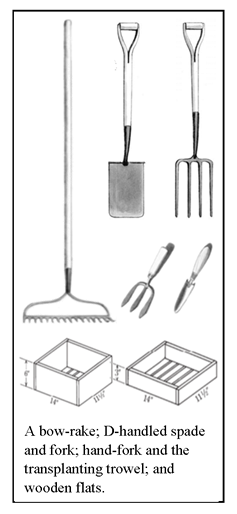Getting Started:
Choosing the Right Tools
Invest in quality tools, keep them clean, use them correctly and they will last a lifetime. D-handled tools are ergonomic and easier to use. A flat spade enables you to double-dig more effectively than a pointed shovel. A spading fork with a good shoulder helps you stay on the tool without slipping off when forking a garden bed. Stainless steel tools slide through the soil easier than forged steel but are not as strong and are typically more expensive. It is important that the handles are made of a durable quality hardwood such as ash or hickory. Plastic or fiberglass handles are lighter weight but do not have the same feel and flex as a natural wooden handle. A good bow rake has a long wooden handle and a metal rake-head with slight flex. This tool is used to level beds after they have been dug and also cultivate soil or chop in amendments. A 3-tine cultivator is another useful tool to have to break up soil clods. A digging board is important and enables you to distribute your weight across the bed and minimize compaction. A 1/2-5/8” thick plywood board cut 2-3’ long by 3-5’ wide works well. You want to be able to sit on it, with your toolsby your side, and also be able to maneuver comfortably as you dig and rake the bed. GB advocates permanent paths and beds to help improve soil structure over time. If you do not have a wheelbarrow, a few 5-gallon buckets are all you need. You can run a small section of an old garden hose over the bucket-handle for comfort. A good hand-fork is useful for transplanting. Be sure to choose a hand-fork which has a nice bend in the neck. Transplanting trowels come in various shapes and sizes. One that is about 2-4” wide and 6-8” long is fine. It is important that seedling flats have at least 3” of root-zone depth. We like to build ours of recycled redwood or cedar; they are rot-resistant and hold up well for years. The flats shown are 3” and 6” deep, the deeper flats for pricked out transplants. (Instructions on how to build your own seedling flats are here.) Keep your tools clean and use them properly and they will last a life-time! Information on these tools and more can be found in How to Grow More Vegetables 9th ed., by John Jeavons. You can see these tools in action at www.growbiointensive.org ♥ top | Newsletter Home |Table of Contents| Archive
|


 One important influence on the GROW BIOINTENSIVE® Method is the French-Intensive Technique which was developed in the 1500s in France and reached its peak in Paris in the mid-1800s. This technique is recognized as being one of the most productive methods of agriculture. Today, we use many of the same tools and techniques which were employed by French-Intensive Market Gardeners.
One important influence on the GROW BIOINTENSIVE® Method is the French-Intensive Technique which was developed in the 1500s in France and reached its peak in Paris in the mid-1800s. This technique is recognized as being one of the most productive methods of agriculture. Today, we use many of the same tools and techniques which were employed by French-Intensive Market Gardeners.